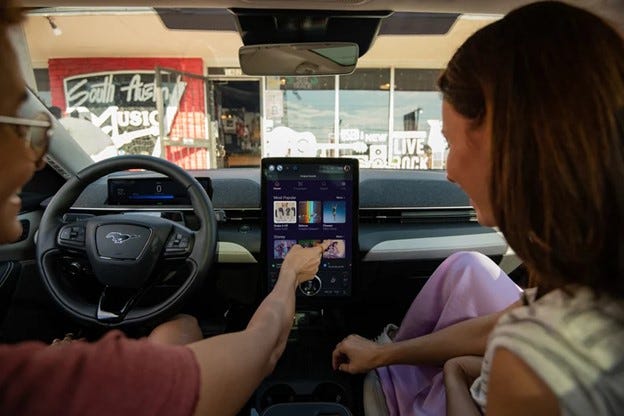EV Quick Hits, October Surprise Edition
EV Reality Gags, Battery Tech Lags, and Sing Along with your Passengers if your EV Battery Sags
My Reality Karma Just Hit Your Zero Emissions Dogma
Proponents of EVs that use them as a tool to promote “clean” energy that is in fact highly toxic, and to “reduce emissions” that are still emitted but just somewhere else, seem to be floating on a sea of half-truths, wishful thinking, and outright fiction that is easily exposed if one merely takes the time to look. It’s not about agreeing to disagree; it’s about whether one is moored in reality or not.
Well, that reality is setting in pretty darn hard. The uncertainty surrounding the “transition” to EVs is causing automakers to severely adjust their plans for manufacturing and engineering development, while suppliers to these automakers are dialing back their financial guidance to their shareholders and lenders.
Consumer demand for EVs isn’t just “softening,” it is crashing. In Europe, a “green” energy haven, registrations for new EV models dropped 16.5 percent year-over-year in the month of August. If this trend continues, automakers will face hefty fines from EU regulators that will enforce fleet emissions rules set to begin next year.
If Germany is any indicator of the EV trouble brewing in Europe, we just might be seeing the end of the EV “transition” altogether. Demand for EVs in Germany, Europe’s largest economy, absolutely imploded, falling 69 percent year-over-year to around 27,000 vehicles registered in August. The media reports that this was due to “slashed incentives” that made EVs less affordable for the working class.
Well, duh. Anyone can see that EVs will only be sold to people if the people are heavily incentivized to purchase one. Otherwise, they’ll buy the gas- or diesel-powered vehicle they actually want. It is not complicated, although the business and automotive media would try to convince us otherwise.
The reality of this “transition” to EVs is that if an entire global population is mandated that they purchase something that is clearly inferior to what is being replaced, the population will simply not comply. Automakers can keep building EVs all they want, and lawmakers can keep demonizing gas- and diesel-powered vehicles.
They can all choke on their unsold inventory of overpriced, battery-operated vehicles that most people don’t want.
This Just In: Customers Want EV Range and Refueling Time to Match That of Gas-Powered Vehicles
The auto industry trade newsletter Automotive News never fails to mystify. A recently published special report looked at “looming improvements” in technology that would help EVs utilize batteries that “pack more energy, allow EVs to drive longer distances, are less prone to thermal runaway, can charge faster, and are less expensive to produce, making EVs more affordable”
How does Automotive News get us to that elusive EV paradise, the one that allows for the same refueling and driving range convenience that we already have with our gas-powered car? Chemistry, my dear reader. The report insists that solid-state battery chemistry in particular is promising because it offers “big jumps in energy density and charging.”
These “breakthrough” inventions, discoveries, and innovations are “within reach.” They’re “pending,” “in the near future,” “forthcoming,” and “imminent.”
We’ll keep hearing about these “breakthrough” technologies, just like we’re hearing about the future nationwide charging network, as being “just around the corner” as a ploy to divert attention from the obvious fact that today’s EV battery technology is simply not suited for the mass market. It is too toxic, too expensive, too heavy, too flammable, has insufficient energy density, cannot be charged in a reasonable amount of time, does not operate well in inclement weather, cannot haul anything except itself and for insufficient distance, and needs to be tethered to a power source when not in use or its energy will drain and eventually render the vehicle inoperable.
Is it too much to ask that the vehicle we are buying is at least as reliable, convenient, and affordable as the one we’re replacing? This whole notion of “buy now, because it will be better coming up” is an insult to our intelligence.
Stranded in your Ford due to a Long Charging Time? Ford Says, “Let’s Do Karaoke!”
Once again, Ford mitigates the ridiculous time it takes to charge its larger EVs by offering a software upgrade to help drivers entertain themselves while they’re stranded at the charging station. Drivers can download the Stingray Karaoke app from the in-vehicle screen on F-150 Lightning and Mustang Mach-E electric vehicles as well as selected gas-powered vehicles with properly equipped infotainment systems.
Yes, you can sing along with your infotainment system while you and your passengers wait upwards to an hour to get your EV charged. “Our goal at Ford is to continue to improve the ownership experience for customers by delivering experiences like Stingray Karaoke that ultimately bring joy,” said the “Connect and Engage General Manager” at Ford that will remain nameless to protect his dignity. “The Ford and Stingray teams worked closely to bring the app to Ford owners so they can make memories with their friends and family no matter where they are on their journey.”
“Make memories?” You mean, like, having to park a depleted EV at a charging station for almost an hour with a car full of passengers that are supposed to sing to avoid passing out from sheer boredom? Those kind of memories? Are you people insane?
Let me suggest an alternative: Ship every EV with lay-flat seats, a pee bottle, and in-dash microwave oven for those hour-long charging “experiences.” Save your Stingray Karaoke app for the Japanese smartphone market.
You’re welcome.





